2023 Santa Cruz Tallboy
Wheel Size: 29’’
Travel: 120 mm rear / 130 mm front
Material: Carbon Fiber
Sizes Offered: XS–XXL
Price: Complete bikes $5,299 to $10,399
Blister’s Measured Weight: 29.2 lb / 13.2 kg (Tallboy X01 AXS RSV, size Large)
Test Location: Washington
Test Duration: 3 months
Reviewer: 6’, 175 lb / 183 cm, 77.4 kg
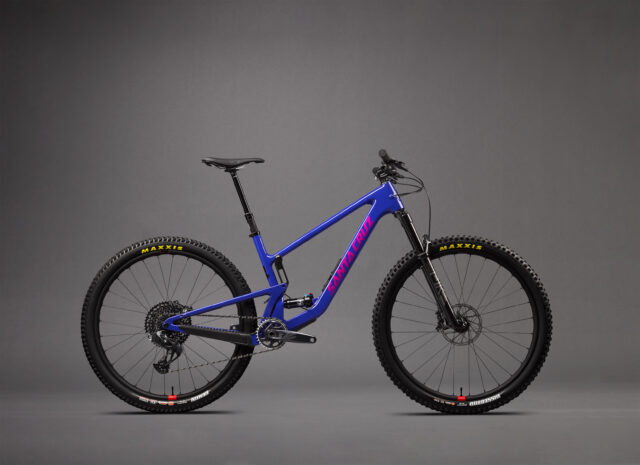
Intro
Santa Cruz has had quite a year, launching new versions of the Megatower, Hightower, Nomad, 5010, and now the Tallboy. And while the shortest-travel bike of the bunch hasn’t seen any wheelsize changes or a dramatic overhaul of its geometry, Santa Cruz has found some details to refine. Let’s dig in:
The Frame
The prior-generation Tallboy V4 was offered in both aluminum and carbon fiber versions, but the new Tallboy V5 comes in carbon fiber, only. The Tallboy still uses Santa Cruz’s familiar lower-link-driven VPP suspension layout to get its 120 mm of rear wheel travel and uses a threaded bottom bracket shell, fully internal cable routing, ample rubber guards on the chainstay, seatstay, and downtube, and so on.
As with Santa Cruz’s other recently-updated models, the Tallboy gets the new “Glovebox” downtube storage underneath the water bottle mount. A “tube purse” and “tool wallet” are included to keep items stored within organized and stop them from rattling around in the frame. The Tallboy also gets a UDH derailleur hanger, Santa Cruz’s typical geometry adjusting flip chip, and ISCG-05 tabs for a chainguide.
And while all the stock builds come with 130mm-travel forks, Santa Cruz condones running the Tallboy with a 140mm-travel one if you’re so inclined. As per usual for Santa Cruz, the Tallboy comes with a lifetime warranty for the original owner, which includes coverage for the pivot bearings.
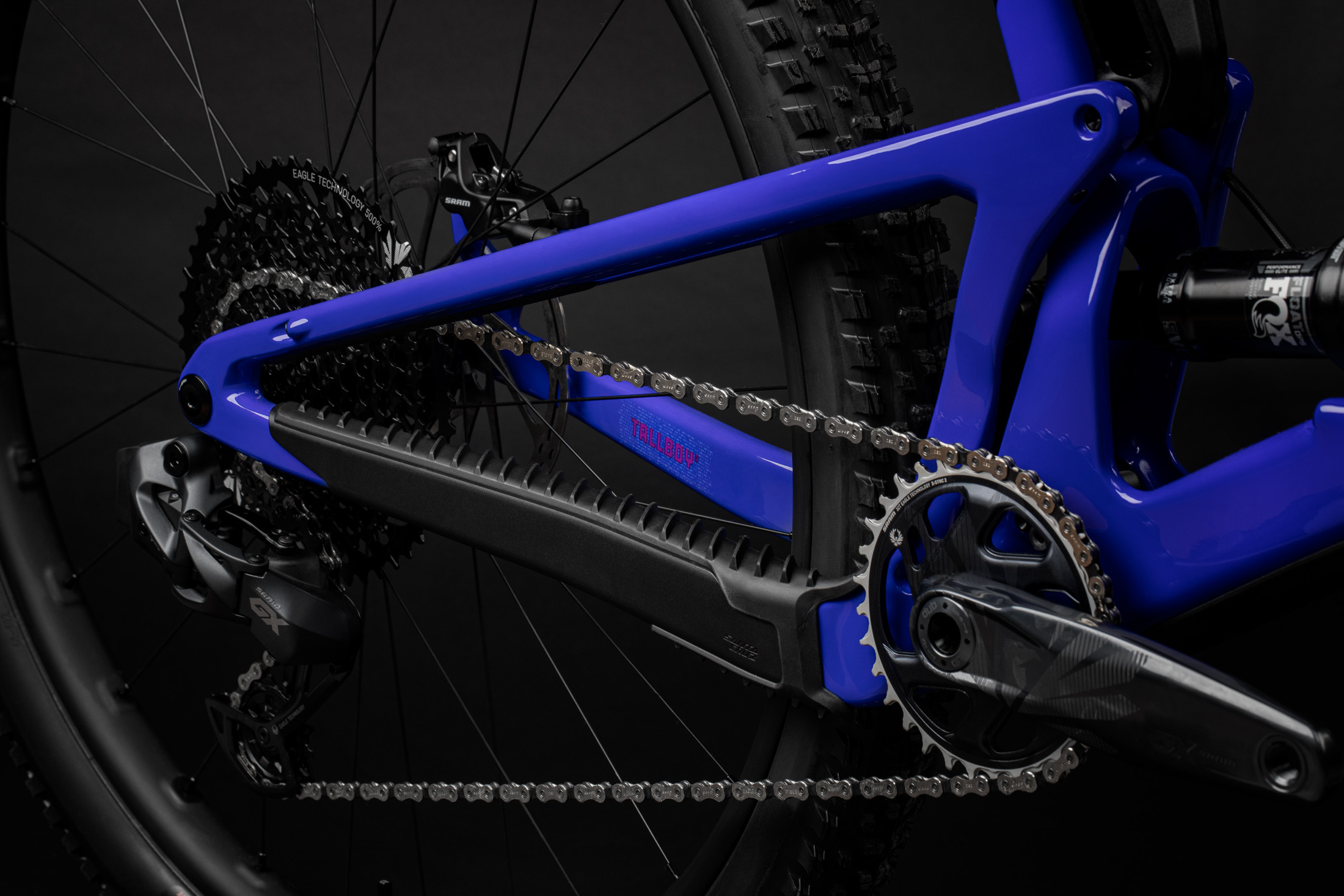
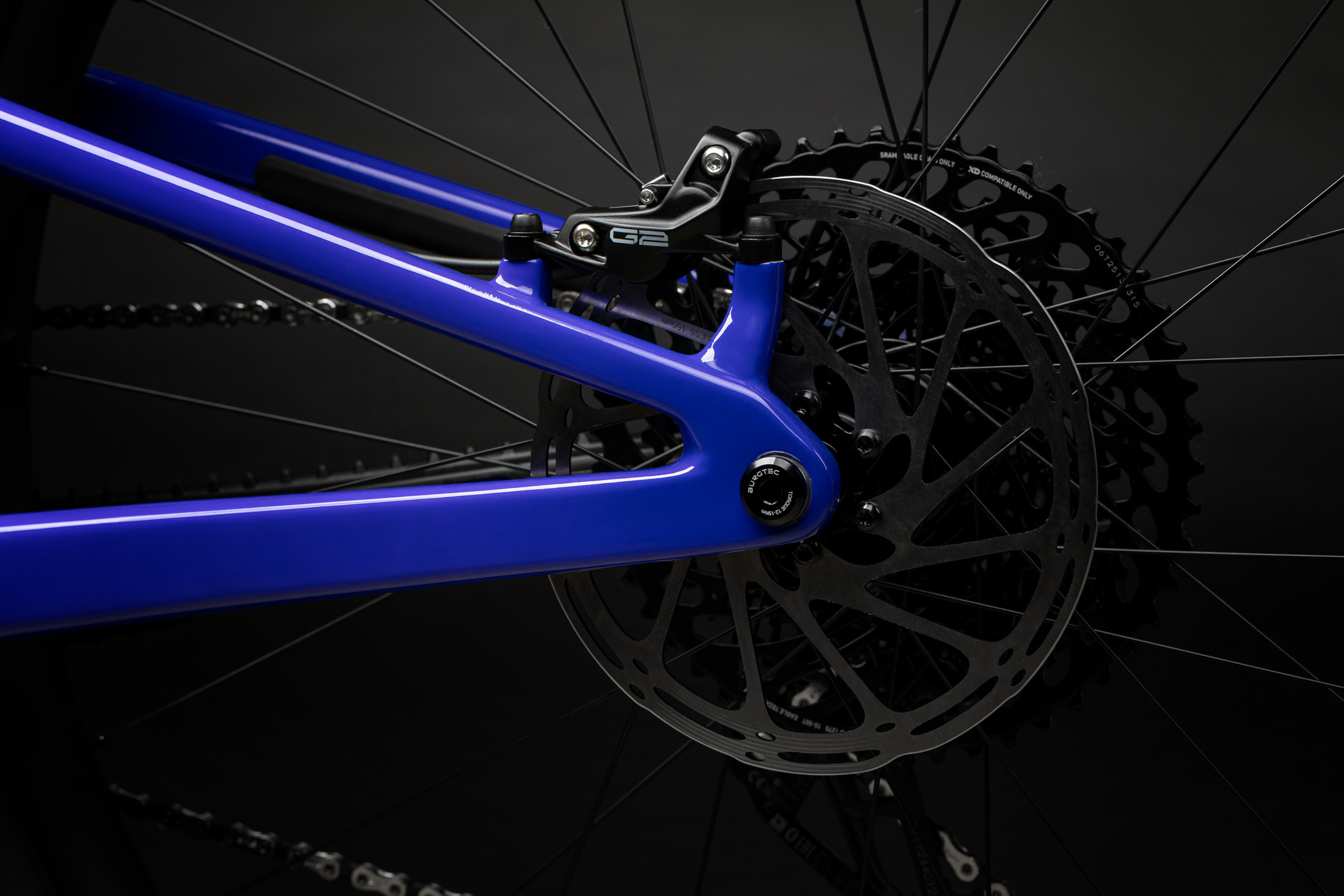
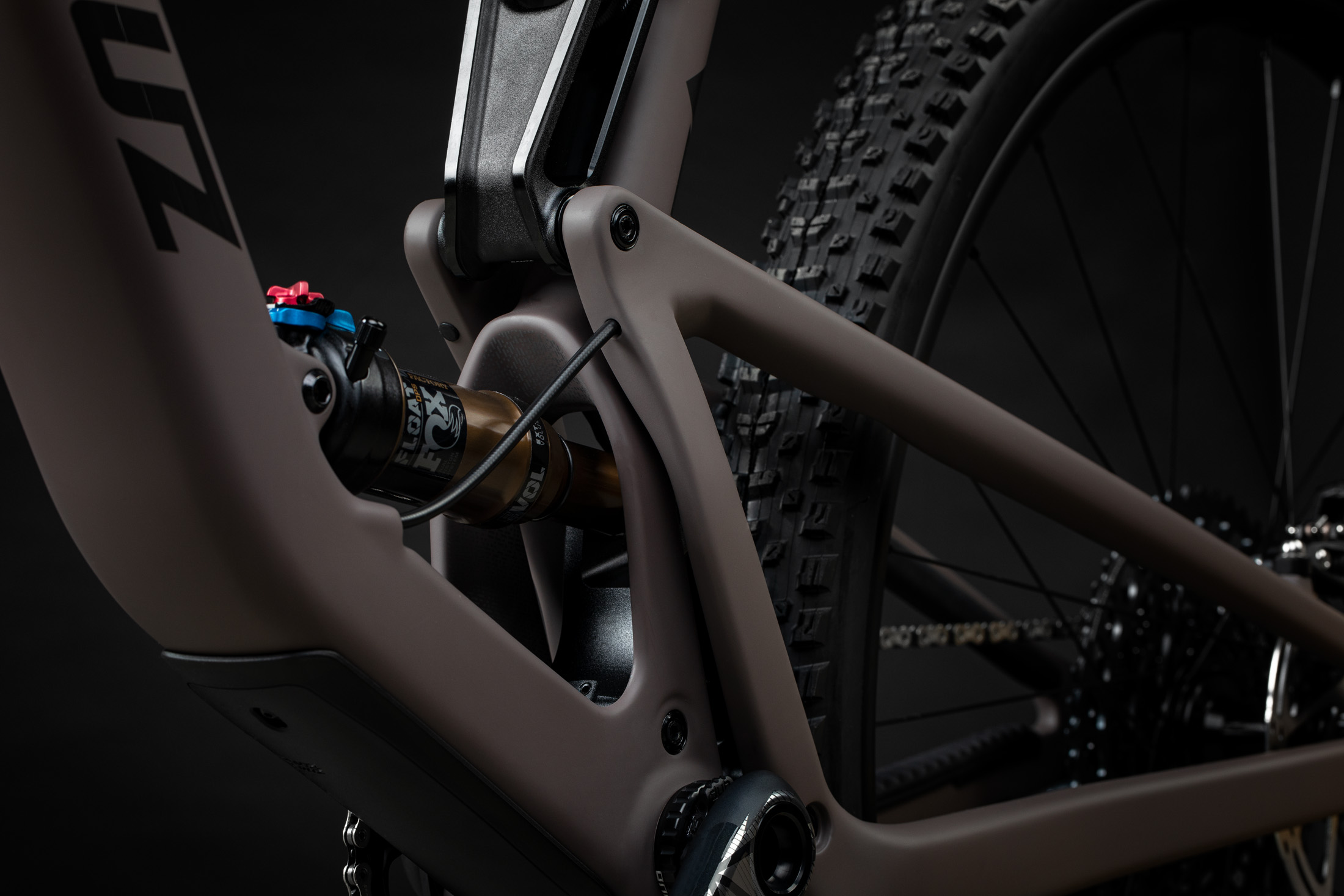
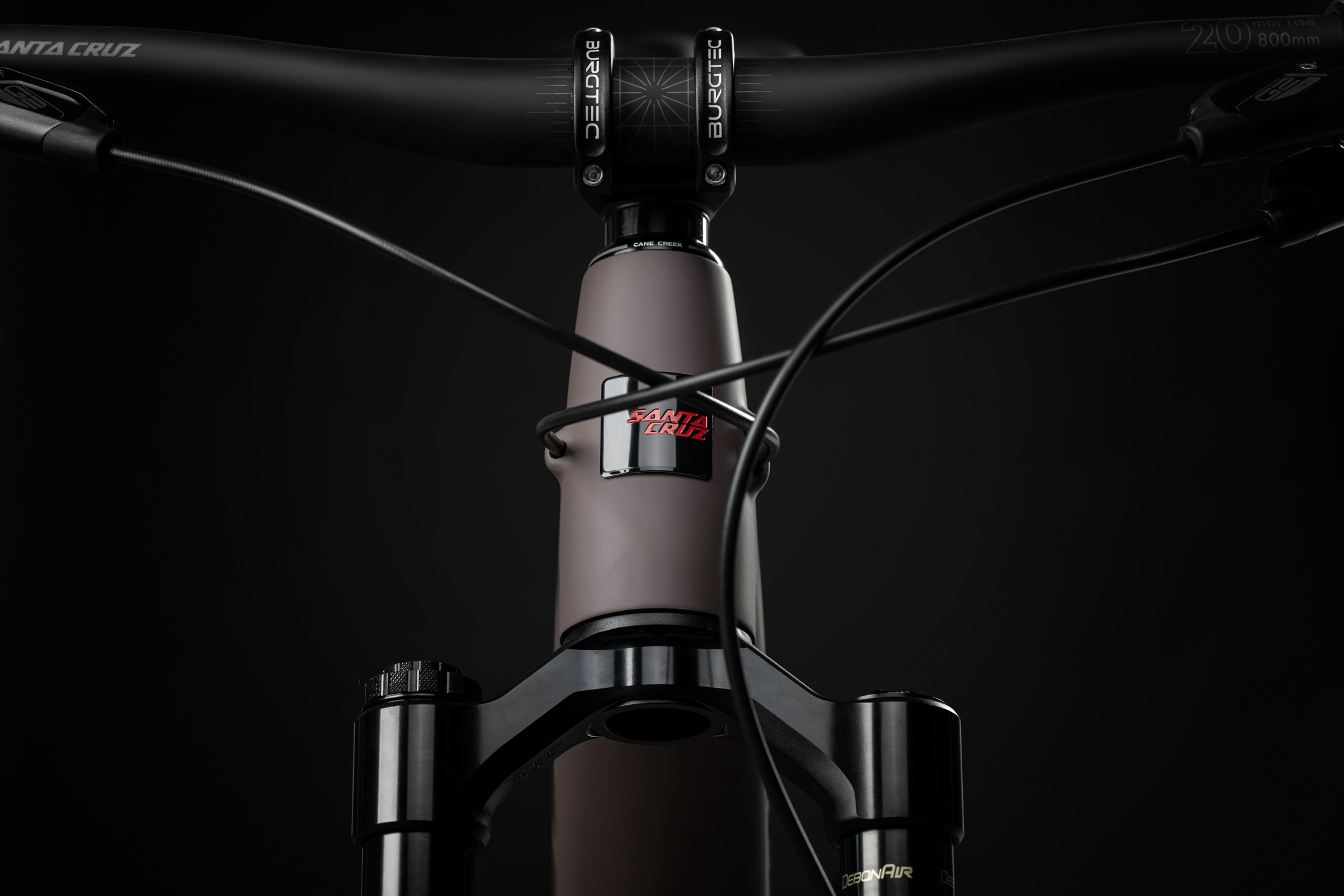
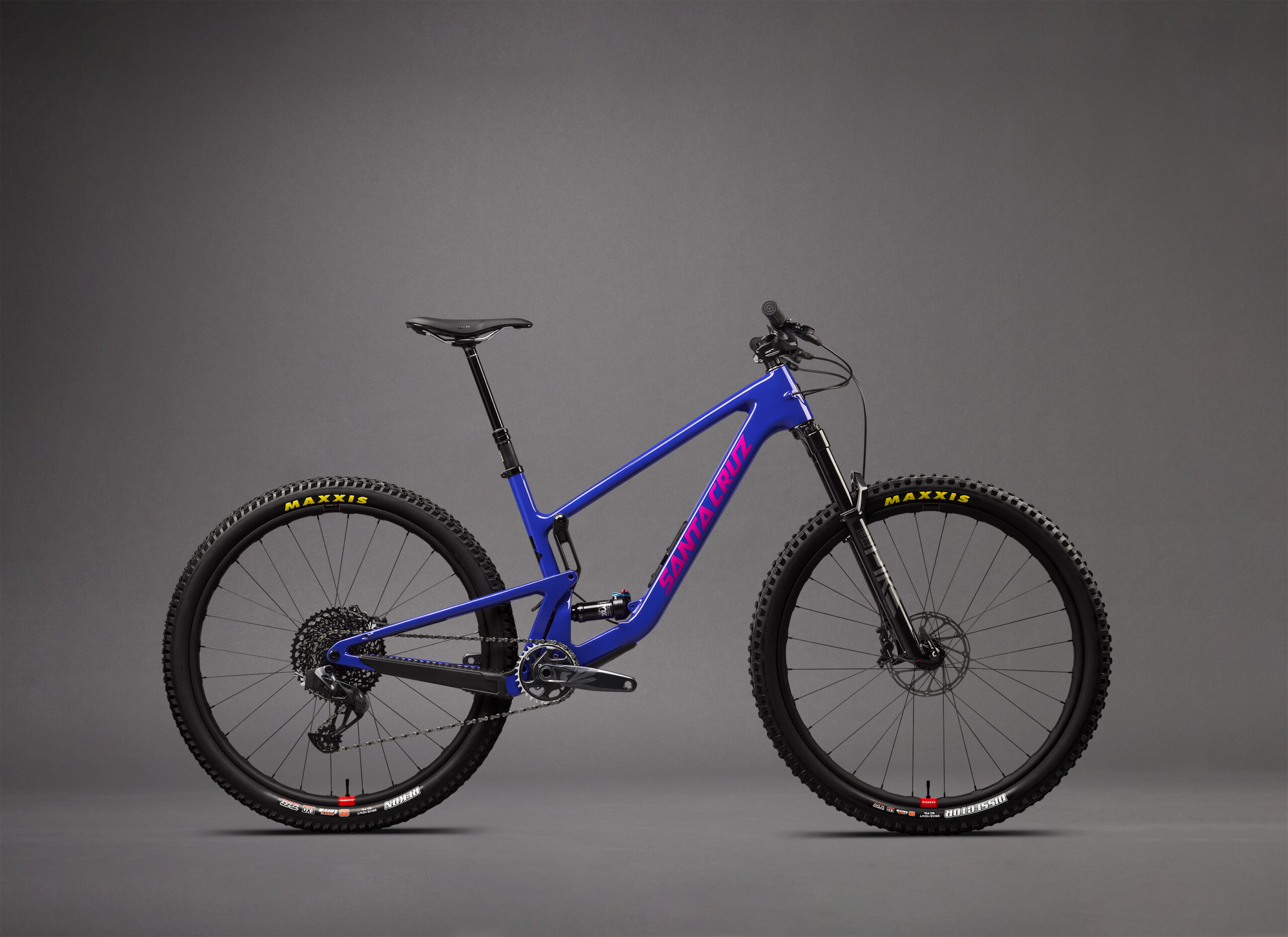
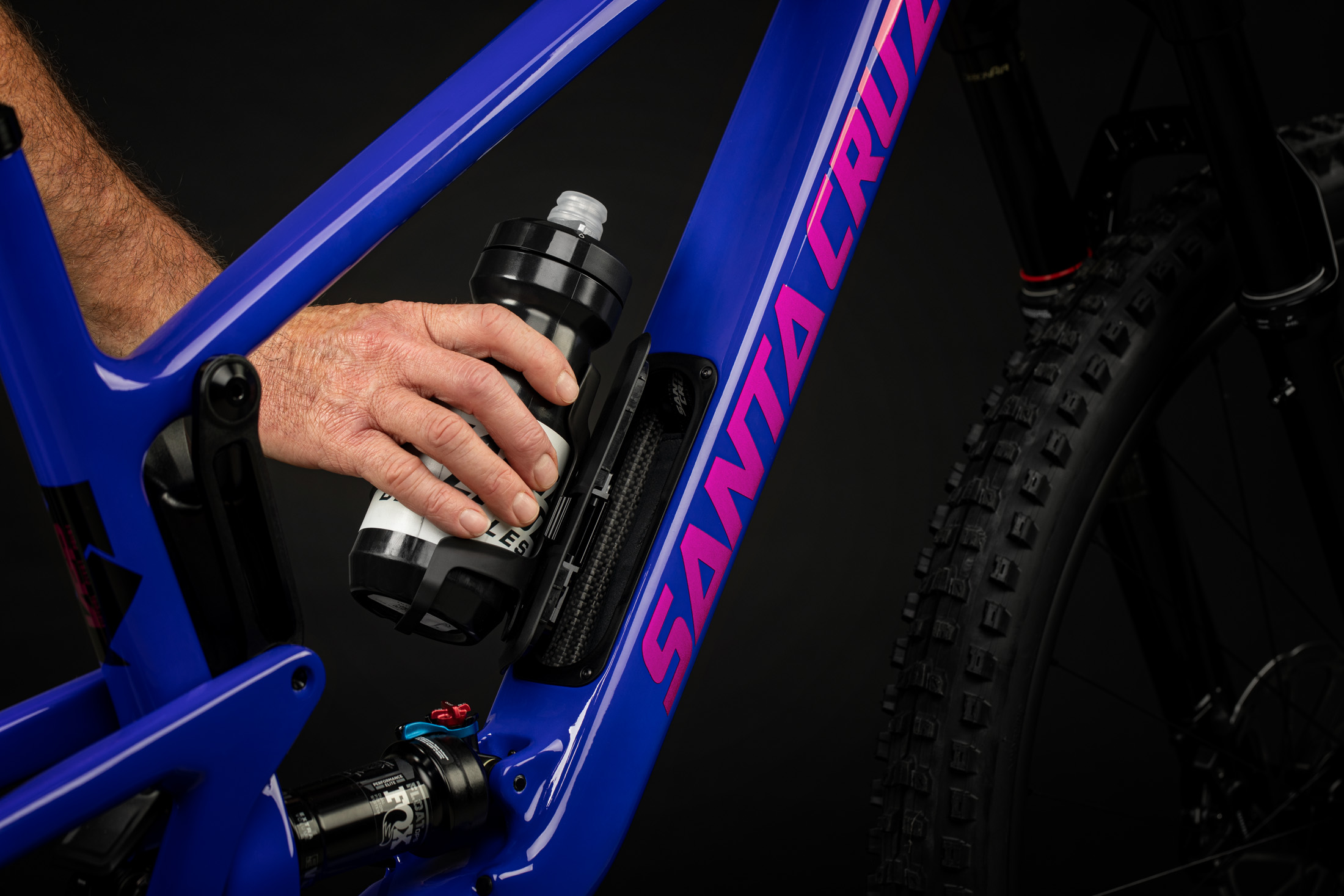
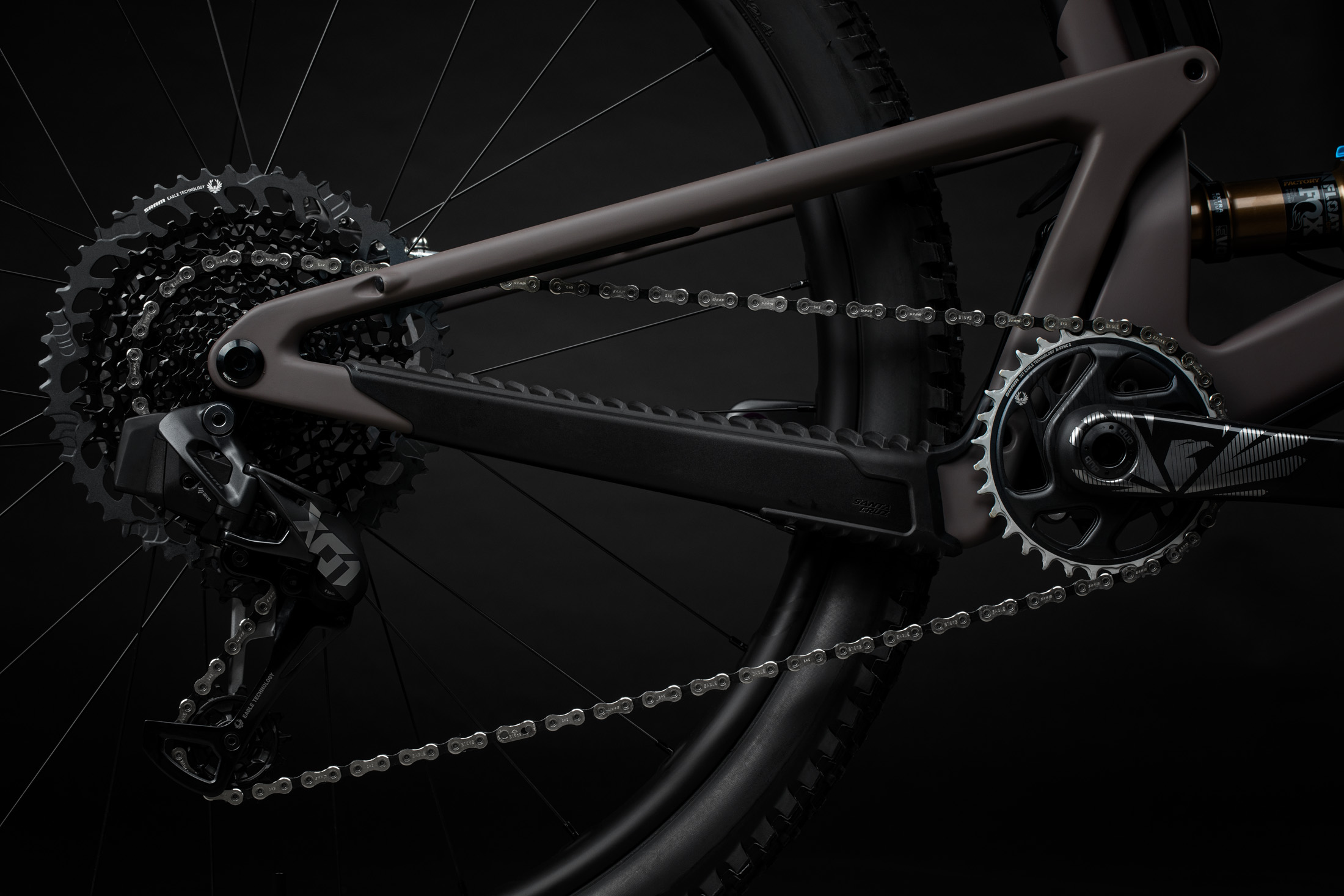
Santa Cruz has also made some tweaks to the suspension kinematics of the Tallboy, but, interestingly, they’ve gone in the opposite direction from the changes they’ve been making to their longer-travel bikes of late by slightly decreasing the amount of overall progression. Santa Cruz’s take is that doing so has resulted in greater sensitivity in the middle of the stroke, by helping the bike ride higher in its travel. With just 120 mm of travel on tap, that makes some sense; keeping suspension riding higher, with more remaining travel left to deal with a given impact, you can wind up with a more sensitive setup without needing to rely on a ton of progression to stop from bottoming out all the time. The Tallboy is still fairly progressive, overall, going from about 3.0:1 to 2.5:1 in a fairly straight line (the curve does flatten out slightly near bottom out) but that’s significantly less progression, overall, than the outgoing Tallboy V4.
The changes to the anti-squat curve, on the other hand, are in keeping with what we’ve been seeing on Santa Cruz’s recent releases, namely a bit less anti-squat early in the travel, but with the curve staying somewhat flatter and not falling off as quickly deeper in the travel. The Tallboy still sits at over 110% anti-squat around sag, which should be penty to keep it fairly efficient, especially on a shorter-travel bike that’ll be set up with overall firmer suspension and therefore not rely on anti-squat as significantly as longer-travel bikes might.
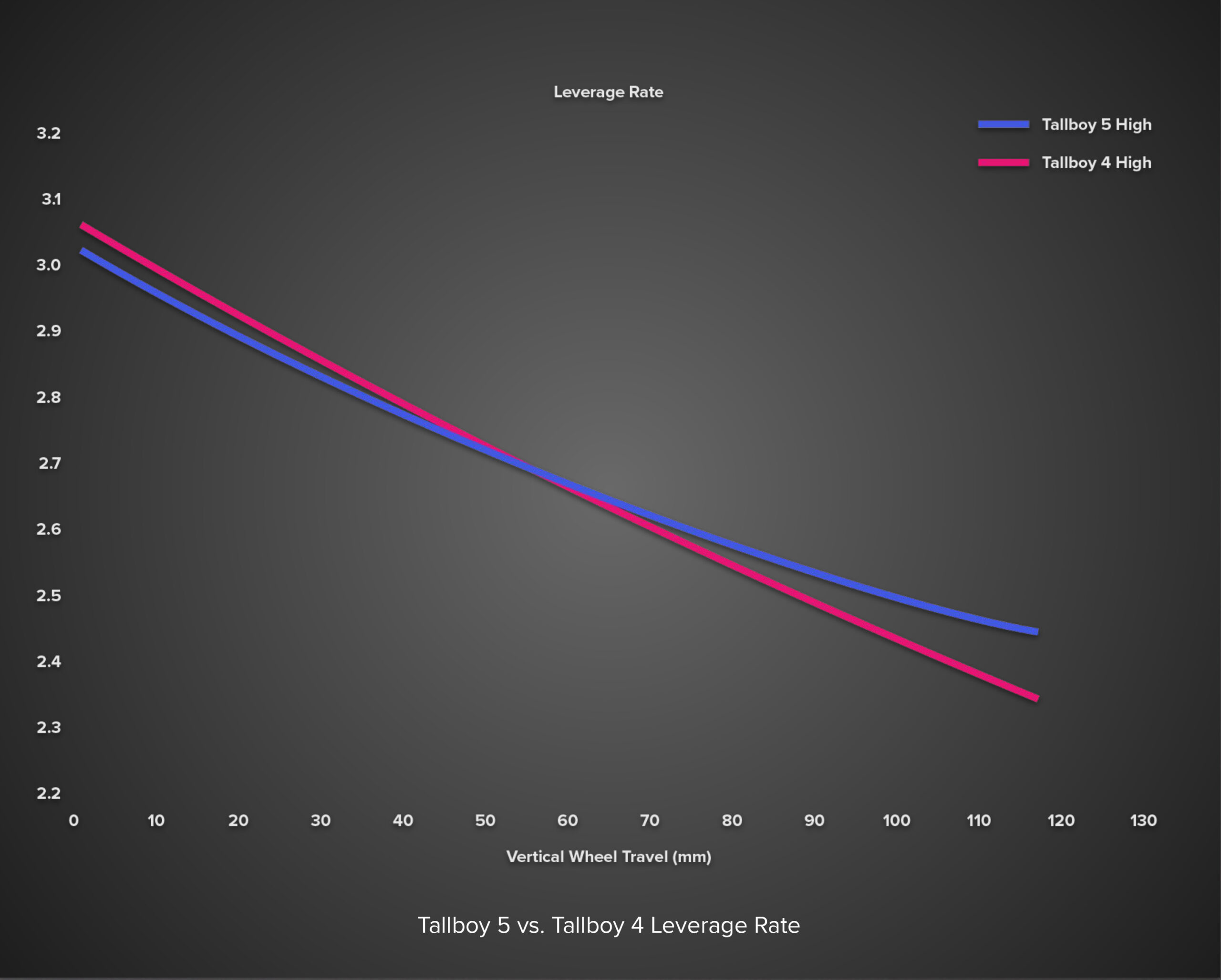
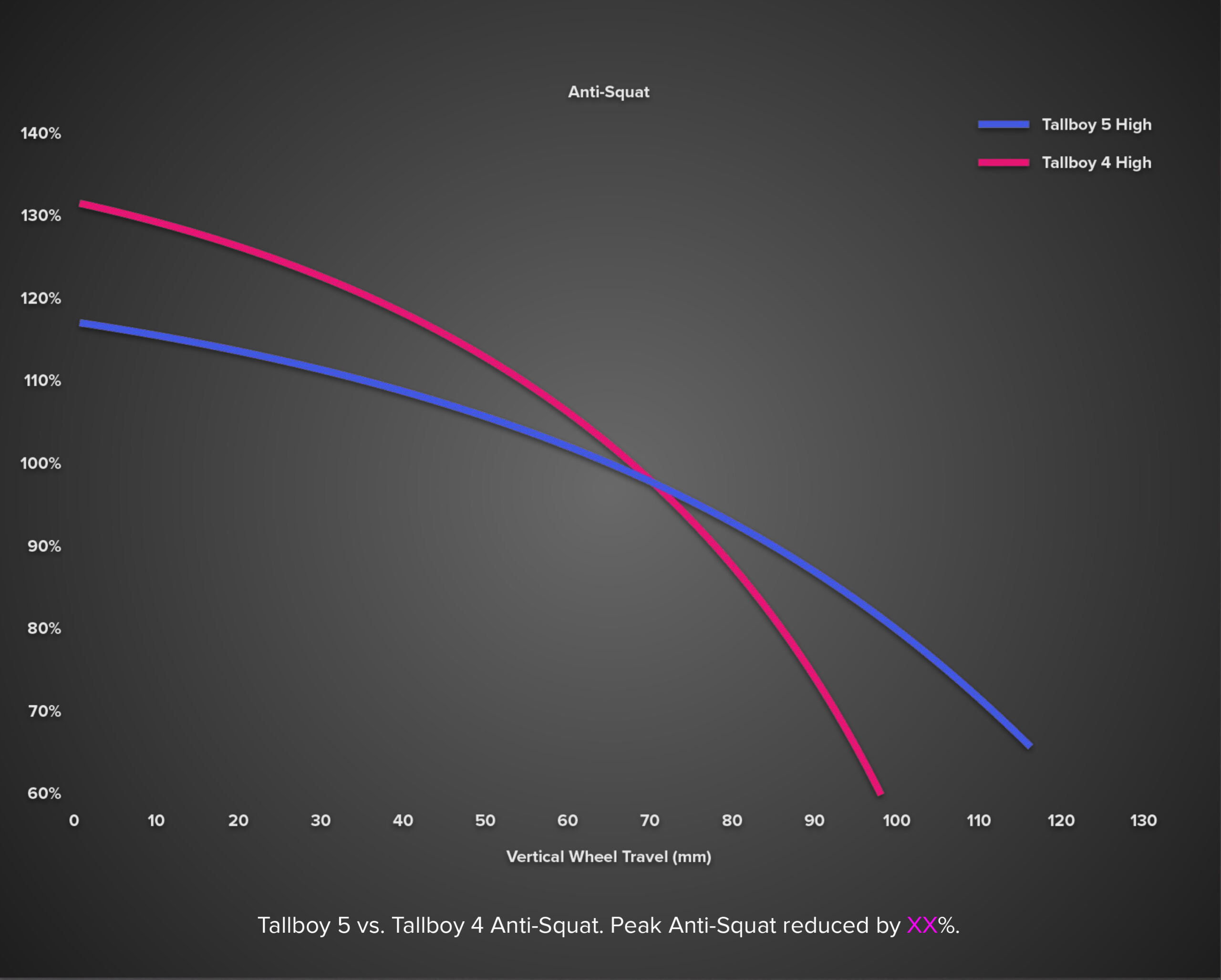
[And if all of that suspension talk didn’t make much sense, check out the Suspension Kinematics section of our Mountain Bike Buyer’s Guide.]
Fit & Geometry
The new Tallboy V5 is offered in the same six sizes as the outgoing bike, XS through XXL, and the geometry hasn’t changed too dramatically, either. The reach has grown by just 5 mm per size (473 mm on our size Large test bike), the headtube angle is still 65.5°, and the seat tube has been steepened by just a few tenths of a degree (around 76.5°, getting slightly steeper in the larger sizes). The most substantial update is the change to size-specific chainstays, which now range from 431 to 444 mm based on size; the prior-generation bike got 436 mm stays across the board. Those numbers are all stated in the low geometry position; switching to the high one steepens the headtube to 65.7°, adds a few millimeters to the reach, and reduces the bottom bracket drop from 41 mm to 38 mm.
That’s still on the progressive side of things for a 120mm-travel Trail bike, which is maybe more of a testament to just how ahead of the curve the V4 Tallboy was when it launched back in 2019 than anything else. But Santa Cruz hasn’t made major changes because they didn’t need to — the Tallboy still looks like “a downhiller’s XC bike”, as Santa Cruz puts it.
The Builds
Santa Cruz offers the Tallboy in six builds that closely mirror those offered on the new 5010 (albeit without the aluminum frame option). As per usual, the X01 builds get the higher-spec CC frame, while the rest feature the more basic C frame.
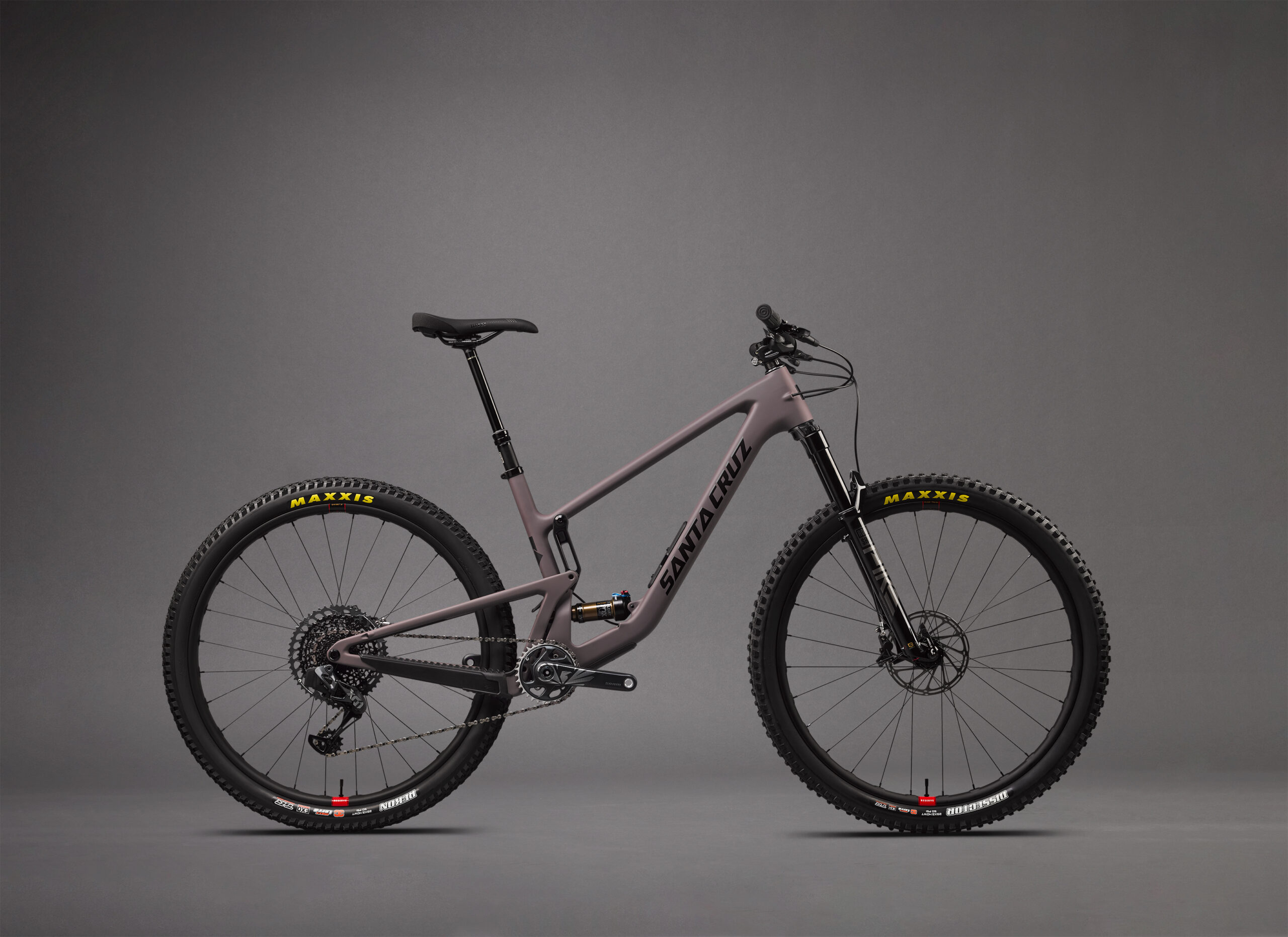
- Fork: RockShox Pike
- Shock: Fox Float DPS Performance
- Drivetrain: SRAM NX
- Brakes: SRAM Guide T w/ 180 mm rotors
- Wheels: RaceFace AR30 rims / SRAM MTH hubs
- Dropper Post: SDG Tellis
- Fork: Fox 34 Performance
- Shock: Fox Float DPS Performance
- Drivetrain: SRAM GX
- Brakes: SRAM G2 R w/ 180 mm rotors
- Wheels: RaceFace AR30 rims / DT Swiss 370 hubs
- Dropper Post: RockShox Reverb
- Fork: RockShox Pike Select+
- Shock: Fox Float DPS Performance
- Drivetrain: SRAM GX AXS
- Brakes: SRAM G2 RS w/ 180 mm rotors
- Wheels: RaceFace ARC30 rims / Industry Nine 1/1 hubs
- Dropper Post: RockShox Reverb
- Fork: RockShox Pike Select+
- Shock: Fox Float DPS Performance
- Drivetrain: SRAM GX AXS
- Brakes: SRAM G2 RS w/ 180 mm rotors
- Wheels: Reserve 30|SL rims / Industry Nine 1/1 hubs
- Dropper Post: RockShox Reverb
- Fork: RockShox Pike Ultimate
- Shock: Fox Float DPS Factory
- Drivetrain: SRAM X01
- Brakes: SRAM G2 RSC w/ 180 mm rotors
- Wheels: RaceFace ARC30 rims / Industry Nine 1/1 hubs
- Dropper Post: RockShox Reverb
- Fork: RockShox Pike Ultimate
- Shock: Fox Float DPS Factory
- Drivetrain: SRAM X01 AXS w/ GX AXS Controller
- Brakes: SRAM G2 RSC w/ 180 mm rotors
- Wheels: Reserve 30|SL rims / Industry Nine 1/1 hubs
- Dropper Post: RockShox Reverb
Some Questions / Things We’re Curious About
(1) The tweaks that Santa Cruz has made to the Tallboy don’t look terribly dramatic on paper, but how will they shake out on the trail?
(2) And how does the Tallboy compare to a bunch of the other more aggressive short-travel Trail bikes we’ve been on recently, including the Rocky Mountain Element, Pivot Trail 429, Guerrilla Gravity Trail Pistol, and more?
Flash Review
Blister Members can read our Flash Review of the new Santa Cruz Tallboy for our initial on-trail impressions. Become a Blister Member now to check out this and all of our Flash Reviews, plus get exclusive deals and discounts on gear, and personalized gear recommendations from us.
Bottom Line (For Now)
The new Tallboy doesn’t look like a wild departure from the prior-generation bike, but it’s got some nice new features including in-frame storage and new size-specific chainstay lengths, and despite not getting major geometry updates, still looks entirely up-to-date as an aggressive short-travel Trail bike that’ll appeal to folks looking for something efficient and lively first and foremost, but that can still be pushed pretty hard when called upon. We’ve got a Tallboy in for review and will be spending a lot of time on it this fall, so stay tuned for a full review.
FULL REVIEW
Intro
When the prior-generation Santa Cruz Tallboy launched back in 2019, it had notably progressive geometry for a 120mm-travel Trail bike and earned a big fanbase as a bike that was still quite efficient and nimble but was a lot more stable and forgiving than many of its heavily XC-derived competitors. But the new Tallboy doesn’t stray too far from the prior one on paper, and a lot more aggressive short-travel bikes have come to market in the interim, so how does the new bike stack up in what is now a very different landscape than the one that its predecessor launched in?

Fit & Sizing
At 6’ (183 cm) tall, I typically land at the upper end of Santa Cruz’s recommended sizing for their Large frames, and that’s the case with the Tallboy as well. But while I’ve been tempted to size up on some of Santa Cruz’s bigger, burlier bikes (most notably the new V2 Megatower), that wasn’t the case with the Tallboy — I really like the fit of the Large.
A lot of that comes down to intended use. The Tallboy is supposed to be more versatile and more engaging in rolling, varied terrain than a bike like the Megatower. The more I’m looking for a bike to inspire confidence going really fast down steep, technical trails, the more I’m inclined to size up (within reason) to both increase the bike’s stability and to give myself more room to move around on the bike in those scenarios. But for a bike like the Tallboy, I’m more inclined to keep the sizing more moderate to make the bike more nimble and easy to throw around, and with that goal in mind, the Large Tallboy felt like clearly the right size for me.
If there’s anything that I would tweak about the fit of the Tallboy, it’s that I’d prefer a slightly taller headtube to get the stack height up a touch. That said, I acknowledge that I’m both at the upper end of the size range for the Large frame and that I’m coming to the Tallboy from a more gravity-oriented background than many folks who’d be drawn to this sort of bike, and I generally prefer to run my bars comparatively high. With the stock setup and the stem set as high as I could get it, I was fairly happy with the fit; bumping the fork up to 140 mm of travel and dropping the stem back down by 5 mm to compensate (more on that in a minute) got it better dialed for me. Swapping in a taller bar probably would have worked, too.

But for the most part, the Tallboy’s fit felt very intuitive and straightforward. The effective top tube definitely feels slightly roomier than a lot of longer-travel bikes, meaning that the Tallboy takes a little extra care to keep the front wheel weighted on very steep climbs, but it felt more comfortable and natural when pedaling while seated just about everywhere else. And I’m happy to see Santa Cruz spec’ing an 800 mm wide handlebar here — most folks (myself included) will probably want to trim it down a little for this sort of bike, but that’s a whole lot easier than replacing the stock bar to go wider, and it’s nice to have the option.
Climbing
The Tallboy climbs very well, especially if you’re interested in a bike that’s still fairly efficient but does a better job than most 120mm-travel bikes of maintaining traction under power. The Tallboy is definitely not the absolute snappiest, most efficient 120mm-travel bike out there (more on that in the Comparisons section, below) but it’s still much sharper feeling than just about anything with significantly more travel, and does that while being impressively composed and forgiving as a technical climber.
When the climbs get ultra-steep, I did need to take a little more care to move forward on the seat and keep the front wheel down than I do on many more winch-and-plummet-oriented Enduro bikes, but the Tallboy never gave me much trouble on that front, and the slightly more moderate (though still steep-ish) seat tube felt like a nice balance for this sort of bike.
If I was really grinding up a steep fire road I’d occasionally flip the Fox Float DPS shock into the firmest climb mode, but for the most part, I preferred to leave it in the middle setting — both going up and down — and not touch it. The firmer setting does improve efficiency and helps the bike ride a little higher in the rear for a steeper dynamic seat tube angle, but also comes at the expense of some traction and comfort; the open position still pedals pretty well, but I found myself preferring the extra support and liveliness of the suspension on the way down in the middle setting, so the middle Goldilocks option worked really well for me in most circumstances.

And for a bike that’s not supposed to be a true XC race bike (Santa Cruz has the Blur for that), but is meant to be a bike for all-day epics and/or an everyday Trail bike for folks who’d prefer something on the more efficient, quick-handling end of the spectrum, I think that’s a really nice place to be. The Tallboy still pedals quite well, but it’s more compliant and comfortable than some of the racier-feeling options out there (e.g. the Rocky Mountain Element) which I think is a worthwhile tradeoff for a lot of folks. I logged my biggest ride of the year — just over 11,000 feet of elevation in about 50 miles — on the Tallboy, and it was extremely well-suited to the task. It’s efficient without being harsh or punishing on rougher climbs, and composed and forgiving enough to still feel predictable when you’ve been in the saddle all day and aren’t at your freshest.
Of course, you don’t have to be doing massive rides to have a good time on the Tallboy — and in particular, it’s a great bike for making tighter, more rolling trails a lot of fun. So on that note:
Descending
The Tallboy descends very, very well for a 120mm-travel bike, but it’s not one that’s going to trick you into thinking you’re on a bigger, burlier bike or anything like that. A better way to look at it is that the Tallboy encourages you to push hard and go fast on the sorts of descents where a 120mm-travel bike is genuinely appropriate; if you start to push it into the sorts of terrain where a bigger bike would be more ideally suited, the Tallboy definitely can start to feel undergunned.
But I don’t mean to damn with faint praise or anything like that, because on the sorts of trails where a more stable, longer-travel bike would feel boring and overkill, the Tallboy is super fun — and really quick if you want to start pushing things. And that’s just what the Tallboy is supposed to do — Santa Cruz calls it an XC bike (or “downhiller’s XC bike”) throughout their marketing materials, and that feels like a refreshingly honest take on what the Tallboy is. It’s not a mini-Enduro bike, but instead a bike for the kinds of big days and varied terrain where an Enduro bike would be overkill and cumbersome, and it’s a really good one.
At just under 30 lb, the Tallboy isn’t that wildly light (nor is it heavy by any means), but if I’d just hopped straight on the bike without weighing it, I would have guessed that it was a couple of pounds lighter. The Tallboy feels agile and light on its feet without being unstable or twitchy, and I think the suspension tuning and frame ride quality have a lot to do with it. The geometry isn’t all that different from things like the Guerrilla Gravity Trail Pistol or Rocky Mountain Element (more on those comparisons below) but the Tallboy feels more lively and easy to throw around, at the expense of a little bit of plantedness and composure. Both of those bikes (especially the Element, at the slacker end of its geometry settings) are substantially more progressive in their leverage curve than the Tallboy, and I think the resulting firmer initial part of the stroke and better support in the first part of the travel do a lot to make the Tallboy feel more lively, and make better use of its limited travel.

Making a bike’s leverage curve relatively progressive can often be a good way to help improve small-bump sensitivity and initial traction without making the suspension soft and wallowy throughout, or prone to bottoming easily, but I’m increasingly sold on the idea that it makes sense to moderate the amount of progression for shorter-travel bikes, and Santa Cruz has done just that with the Tallboy. With just 120 mm of travel on tap, it’s not going to be ultra-plush and cushy no matter how it’s set up, and the slightly firmer initial portion of the travel both makes the bike pedal better and feel snappier, while also keeping it up in its travel with more of its limited reserves on tap for when you really need them. It’s nothing too crazy conceptually, but the tuning that Santa Cruz has done with the Tallboy is excellent.
In terms of the body positioning that the Tallboy encourages, it feels fairly neutral, not favoring an especially forward stance or a particularly centered one. I found it to be intuitive and relatively adaptable to being ridden with a variety of approaches. As someone who’s (1) at the tall end of the range for the size Large frame that I tested and (2) spends more time on longer-travel, more gravity-oriented bikes and is more used to more upright setups, I did find myself wanting to run the bars at the higher end of the range afforded by the steerer tube spacers, but the Tallboy didn’t feel unbalanced or out of joint with the bars dropped for a more aggressive stance.
In part due to my interest in getting the bars higher, and partly because I was curious what it would do to the Tallboy’s handling, I also tried bumping the stock Pike Ultimate up to 140 mm of travel by way of a longer air shaft (which Santa Cruz officially condones on the Tallboy) and the results were both predictable and not especially dramatic. With the taller front end and slacker headtube, the Tallboy felt slightly calmer handling and a touch less agile, but the differences were by no means major; if anything, the slight change to the cockpit dimensions and slightly taller bar height made a bigger difference (for the better, given my preferences).
Mostly, though, the Tallboy feels really nicely sorted out as a bike that’s meant to encourage you to go fast on the kinds of trails where a 120mm-travel bike is most at home. It pedals well, does a great job of building speed by pumping and riding dynamically when given the opportunity, and hits a nice middle ground of being nimble in tighter spots without feeling twitchy and unstable until you start really pushing it beyond its comfort zone. The Tallboy isn’t trying to be a “mini-Enduro bike” or anything like that, and it’s more versatile for it.
The Build
Santa Cruz sent over the Tallboy with the top-spec X01 AXS RSV build, which, unsurprisingly, didn’t leave a whole lot to be desired. As discussed above, the new RockShox Pike fork was a particular standout, the Reserve 30|SL wheels rode great, and so on — it’s a really nice build (and is priced accordingly).
That said, the SRAM G2 RSC brakes aren’t exactly the most powerful, especially with 180 mm rotors at both ends. I don’t think that I can quite make the case that the Tallboy should come with Codes (though I wouldn’t be mad about it if it did); the weight difference between the two is real, and the stock G2s will be enough for a lot of folks on the Tallboy. But I wanted more brake and swapped in a 203 mm front rotor and Galfer Pro pads at both ends to help out. That was enough to make me happy on the sorts of trails that I’d call the Tallboy’s true wheelhouse; if I started to push the boundaries a little and take it into some steeper, longer descents than it’s strictly intended for, the brakes started to feel like something of a limiting factor again.

Our review bike also came with the 52-tooth version of the SRAM X01 cassette, instead of the 50-tooth one that’s typically spec’d as standard — thank supply chain issues for that one. I’ve complained about SRAM’s 52-tooth cassettes having too large a jump in gear ratios between first and second gears before (apart from the largest cog, the 50- and 52-tooth cassettes are identical) but that gap was especially irritating on the Tallboy, a bike that encourages you to climb quickly and really put power down when possible. I often found myself in second gear and looking to go one lower, only to shift into first and feel like I had spun to a halt. I happened to have a 50-tooth version of that cassette on hand, so I swapped it in for the better part of the test period, and indeed found it to be an improvement.
The good news is that the Tallboy is supposed to come with a 50-tooth cassette and that currently-shipping builds will do so; the bad news is that due to supply chain headaches, Santa Cruz is currently having to substitute in GX cassettes and chains in place of X01 ones on builds that are meant to have the latter. The price of those builds has been dropped by $350 until X01 bits start showing up again.
I also did a bunch of experimenting with different tires on the Tallboy. I’m not mad about the 2.4’’ Maxxis Dissector front / Rekon rear combination, especially in drier, firmer conditions, where they offer a nice combination of very quick rolling and decent grip. The softer and wetter things got, the more I was interested in running more aggressive tires, so I tried a whole spectrum of options up to a 2.5’’ MaxxGrip / DoubleDown Minion DHF front / 2.4’’ MaxxTerra / DoubleDown Minion DHR II rear package, with a few intermediate configurations in the mix as well.
The results were predictable — each step to grippier, heavier tires made the Tallboy more confidence-inspiring when pushed hard, but correspondingly slower rolling and more sluggish. There’s no one correct answer here, and I think the stock spec will work great for folks interested in keeping things light and snappy, but it’s not at all crazy to go beefier if you want some extra grip and stability. (For what it’s worth, the one and only Greg Minnaar was recently photographed with 2.5’’ Assegais on both ends of his Tallboy, though I wasn’t able to make out casing or rubber compounds.)

Comparisons
Santa Cruz Tallboy V4
I unfortunately only have a few rides on the prior-generation Tallboy (and they weren’t particularly recent) but my impressions are that the changes Santa Cruz has made to the latest Tallboy are pretty similar to what I said about the new Hightower V3 earlier this year — it’s not wildly different from the bike it replaced, but feels like the suspension kinematics have been refined nicely, and some of the other updates (e.g. the addition of the Glovebox) are nice touches, too.
Specifically, the rear suspension on the new Tallboy feels smoother and more consistent through medium-sized chatter. I think the improved midstroke support, which keeps the suspension riding a little higher, with more travel in reserve for when you really need it, plus the slightly moderated anti-squat for less suspension-chain tension interaction, work in concert nicely here. Do the changes make for a dramatically different experience than the old Tallboy? Definitely not. But as we’ve said many, many times here at Blister, we’re all for leaving a good thing alone rather than making change for change’s sake, and Santa Cruz has done a nice job of refining some of the little details of the Tallboy without ruining what made the old one great.
The Rocky Mountain Element is probably the best comparison here after the prior-generation Tallboy, but there are still some real differences — primarily the suspension performance. The Element comes with the much lighter, more XC-oriented Fox 34 Fit4, whereas most of the Tallboy builds come with the heavier, stiffer, higher-performing RockShox Pike. And especially with the Element set to the slacker end of its adjustment range (which also alters the suspension kinematics), the rear suspension of the Element feels much more progressive and somewhat less supportive and lively than that of the Tallboy.
Frankly, that extra support helps the Tallboy make better use of its 120mm of travel than the Element does, and the Tallboy feels more composed on medium-sized chatter in particular. The Element is a little more stable at speed (at least in terms of its geometry and handling) and pedals slightly more efficiently, but the Tallboy’s better suspension makes it the more forgiving, composed option. The Element feels more game-on and demanding and is probably the better option if you want something to specifically feel race-oriented and fast, at the expense of it feeling more demanding. The Tallboy is the more versatile all-rounder.
I have less time on the Ripley than I’d like, but my early impression is that it’s a little sharper handling and not quite as stable at speed as the Tallboy, and generally feels a touch more XC-oriented while the Tallboy is the more aggressive option of the two. The gap between them isn’t huge — they’re definitely worth cross-shopping against each other, rather than feeling like they’re some sort of categorical mismatch — but the decision one way or the other should essentially come down to whether you’d prioritize especially quick handling (Ripley) or a bit more composure and stability at speed and on steeper trails (Tallboy).
We’ve unfortunately had different reviewers on the Phantom than the Tallboy, but from talking to our folks who’ve ridden the Banshee, it sounds like “more” bike in most respects — heavier, more stable and planted, less snappy handling, and less lively. Which one makes the most sense is going to come down to your priorities and how you intend to use the bike. The Phantom also sounds like it favors a more neutral, centered stance than the Tallboy, which doesn’t feel especially forward-biased but does work best with a little effort to keep the front wheel weighted.
Guerrilla Gravity Trail Pistol
The Trail Pistol feels more like a scaled-down Enduro bike than the Tallboy does (especially with the Trail Pistol in my preferred configuration, with a 140mm-travel fork and a 55mm-stroke shock, for 130 mm of rear wheel travel). The Tallboy pedals more efficiently, is a little quicker handling, and feels sharper and more lively, both in terms of handling and suspension performance. The Trail Pistol is more composed on steep, rough trails at speed, but needs to be going faster and be ridden with a more aggressive touch to come alive.
Similar story as the Trail Pistol. The Spectral 125 is also more stable at speed and less engaging in more rolling, varied terrain than the Tallboy. The Tallboy pedals more efficiently and its suspension feels more composed in rougher sections (in much the same way that the Element can’t keep up with the Tallboy on that front) but the longer wheelbase and calmer steering of the Spectral 125 still make it the harder-charging bike if you can ride it precisely and hang on through the rougher bits. The Spectral 125 is a lot of fun if you want a bike to spice up burlier trails that you’d typically ride on a bigger bike, but the Tallboy is probably the more versatile option for most folks.

Who’s It For?
The Santa Cruz Tallboy is for people who want an efficient, sharp-handling Trail bike that can handle some occasional excursions into bigger terrain, but is most at home going fast and covering a lot of ground on the sorts of trails where a bigger, slacker bike would feel like overkill.
I want to be careful not to sell the Tallboy short in terms of what it can handle — I’ve ridden some burly trails on it and the Tallboy can get the job done if you dial things back a bit and take care to ride cleanly. But rather than being a short-travel bike that wants to punch well above its travel class and winds up as a super-niche option that isn’t especially engaging on mellower trails and needs to be ridden ultra-precisely on more challenging ones, the Tallboy is content to stay in its lane and be a regular short-travel Trail bike — and it’s a really good one.
Bottom Line
The class of ~120mm-travel Trail bikes is an interesting one, with bikes that feel very XC-derived and efficient all the way to burly mini-Enduro bikes that take a lot of speed and aggression to come alive, but roll that into a more compact, lively package than the true big bikes that they’re based on. The Tallboy lands in the middle of that spectrum and feels best suited to folks who want a bike that’s efficient and engaging on more rolling, varied trails first and foremost, but is more compliant, composed, and stable than the most ultra-snappy XC-oriented bikes in the class.
And with those goals in mind, the Tallboy really stands out for its suspension performance in particular. Santa Cruz maybe hasn’t done anything too radical with the new Tallboy, but it’s extremely well-refined, and for a bike that’s supposed to be more versatile than hyper-specialized, that’s 100% the right target. The new Tallboy isn’t cheap and isn’t a wild departure from the prior-generation one, but it’s very, very good.

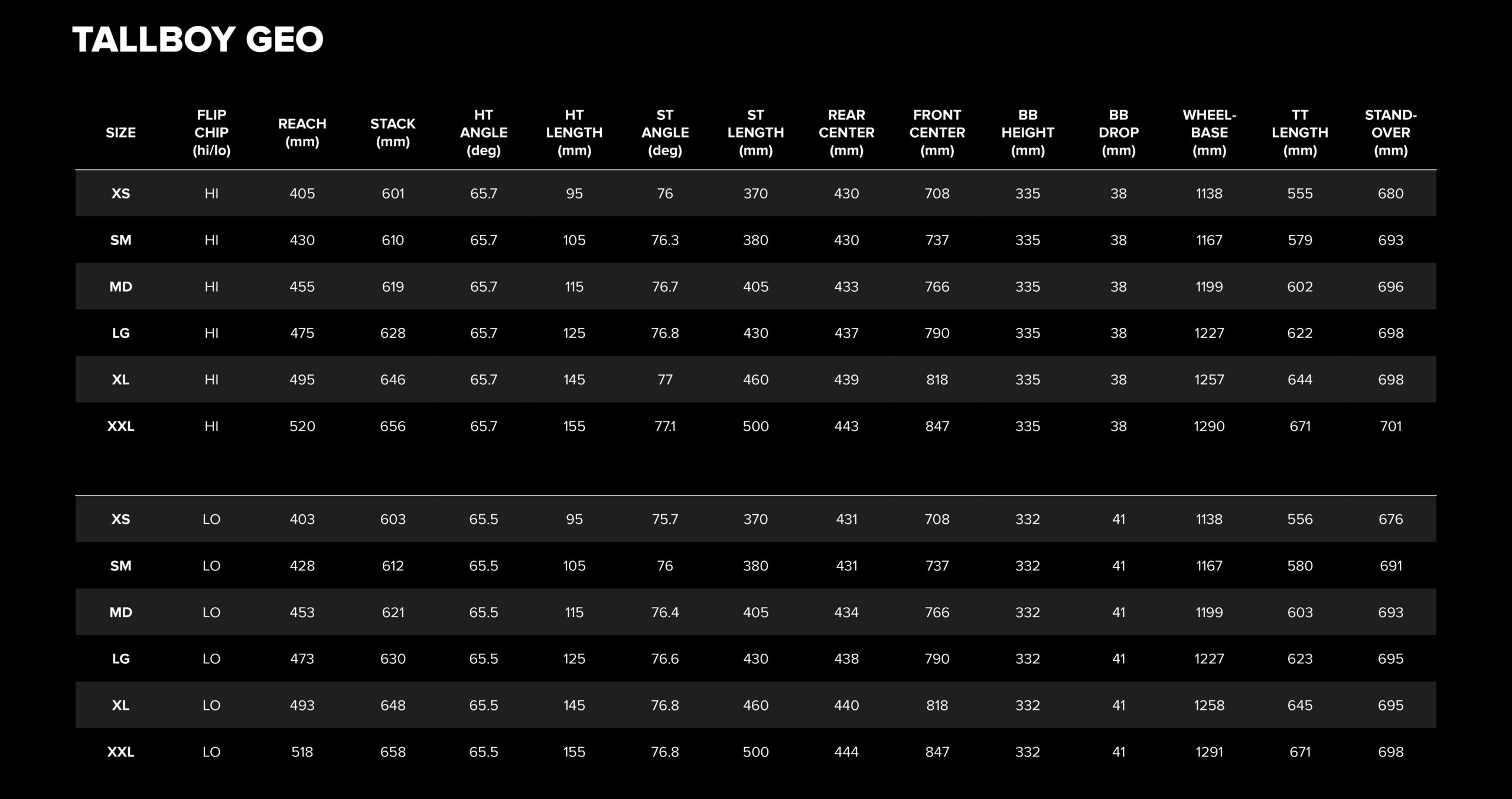
Thoughtful review. SC bikes have certainly become price leaders, and not in a good way.
I’m with you on the SRAM 42-52 jump. Too big. The 42-50 is bad enough. Shimano has this nailed at 45-51.
Any plans to test a Reeb SST in the future? It has similar (on paper) specs to the new Tallboy. Interested to see how it compares.
Any comparisons to Pivot Trail 429 or Trek Top Fuel?
+1 for this!
We’ve had different reviewers on the Tallboy and Trail 429, but from talking to our folks who’ve ridden the latter, my hunch is that they’re a pretty good comparison for each other, with the Pivot probably being a touch more efficient and snappy, and the Tallboy being a little more plush and forgiving in terms of suspension performance.
We haven’t been on the current Top Fuel, unfortunately.
Nice review!
Do you have long legs? What’s your inseam?
I’m 6’1 with so I’m right in between L and XL. However my inseam is 35 so I think a Large should suits me better than a XL.. What do you think?
Thanks.
My leg length is pretty average — I’m running a ~785 mm seat height with 170 mm cranks. If you’d like to have a more in-depth chat about fit, sign up for a Blister Membership and drop us a line through the form in the Blister Member’s Clubhouse!